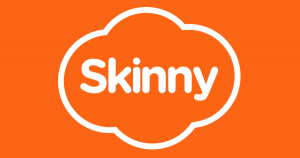Craig Jones becoming the literal embodiment of one of his brands.
Your brand is summed up by the way your company interacts with the community. Every touch point, from the way you meet new customers to the way you send them the bill, from the way your staff deal with each other and the tone of voice your social media managers use when they do an Instagram story. It can all be a representation of your brand. Because of it’s broad scope, it’s easy to understand why branding is really important to get right!
As an example, think about New Zealand’s current phone network providers. On the on end of the spectrum we have Spark right through to Skinny Mobile:

Spark suggests a focus on reliability and innovation.

Vodafone, while still seeming to be reliable, has also managed to position itself to a younger audience (in part thanks to sponsorship of events and sports teams).

With 2Degrees, even the name alone emphasises its focus on bringing people together. They’re probably that friend at the party that loves to mingle and help others meet new people.

Finally, Skinny have embraced an advertising campaign that isn’t afraid to laugh at itself and be a bit quirky.
So, there are four brands all offering similar services at not-too-dissimilar prices, but each carving out its own space in the mindset of Kiwi consumers through intentional brand personality creation.
The Attractive Personality
Can you remember the last time you met someone who lacked personality? Or someone who showed up with a tonne of energy? The one with more energy is the one you’d likely want to be friends with, right?
It’s the same with businesses. A brand with no personality may win some customers over with reduced prices, but alongside another brand with an appealing personality, the attractive business wins every time. At the same price, do you go for the “No Frills” basketball sneakers or the Air Jordans?
Getting the Match Right
Of course, a brand personality doesn’t just flow from the personality of the founder/s of the business. Especially as the business grows, it needs to be fuelled by what your core target market would find most attractive. Are they looking for a brand that is trustworthy or relaxed or welcoming or hip or extravagant or understated?
This is where intentionally listening to your audience and customers is so important. You can do this through feedback forms, regular communication and brainstorming between frontline sales and customer service personnel with the marketing and brand team, and surveys and other forms of research. A little info can go a long way.
The real art of creating a good brand is understanding who you are trying to connect with, and how to speak in their language…. While staying authentic to who you are!
Defining Your Brand Personality
With some customer feedback and research under your belt, refining your brand can become a fun brainstorming task. Ask yourself, if my brand was a person …
- What do they look like? Friendly and approachable or corporate and professional?
- How would they talk? In a casual or direct manner?
- How would they act? Bold or are they a quiet achiever?
Imagine your brand walking into a dinner party or a bar or other social setting (one that might suit your target market), what impact do they leave on the room? What conversations do they spark? What makes them remarkable in that setting?
So, today as you go about your business, have a think about how you want your brand to be remembered. If you’d like to explore ideas, we’re always up for a chat over coffee!

